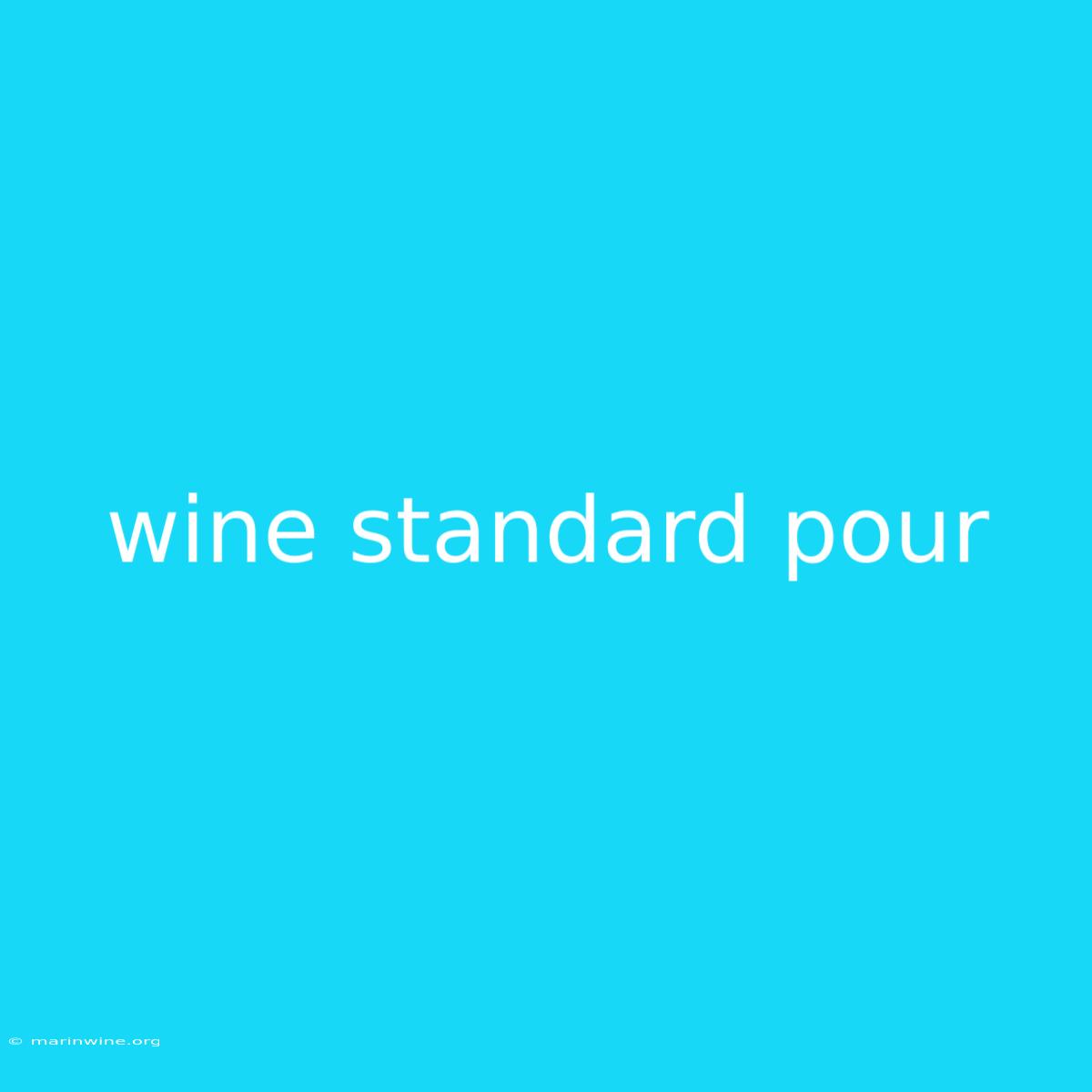The Perfect Pour: Unveiling the Wine Standard Pour
Have you ever wondered how much wine is "just right" for a glass? It's not just about getting your fill, but about enjoying the wine's flavors and aromas at their peak. Enter the wine standard pour, a guideline that ensures you get the optimal experience with each glass.
Why It Matters
The standard pour isn't just a random number. It's based on scientific principles and wine etiquette, impacting both your enjoyment and the restaurant's bottom line. This guide helps maintain consistency in serving sizes, ensuring fair pricing and allowing customers to appreciate the nuances of the wine.
Key Takeaways of Wine Standard Pour
| Takeaway | Description |
|---|---|
| Standard Pour: 5 oz (150 ml) | The recommended amount for a single serving of wine. |
| Serving Size: Impacts Pricing | Restaurants use the standard pour to calculate wine prices accurately. |
| Optimizes Flavor & Aroma: | The right amount allows the wine to breathe and express its full potential. |
| Wine Etiquette: | Adhering to the standard pour is considered good practice in professional settings. |
| Variations: | Some regions or venues may have slightly different standards, but 5 oz is generally the norm. |
The Wine Standard Pour: A Deeper Dive
Understanding the Basics:
The standard pour of 5 ounces (150 milliliters) is often cited as the ideal amount for a single serving of wine. This measurement balances the wine's flavor profile with its ability to breathe and express its aromatic qualities. The goal is to ensure that the wine is enjoyed at its peak, with each sip offering a balanced and enjoyable experience.
Factors Influencing the Pour:
- Wine Style: Lighter wines, such as Sauvignon Blanc or Pinot Grigio, tend to be poured slightly smaller, while full-bodied reds like Cabernet Sauvignon or Syrah receive a slightly larger pour.
- Glass Size: The size and shape of the glass can also influence the pour. Larger, tulip-shaped glasses are typically used for red wines, allowing for more surface area and aeration, whereas narrower, taller glasses are often used for white wines.
- Temperature: The temperature at which the wine is served can also affect the pour. Red wines are typically served at a slightly warmer temperature, encouraging their aromas to open up, while white wines are usually served chilled, leading to a more crisp and refreshing experience.
Exploring the Connection between Pour Size and Flavor:
A smaller pour offers more intense flavors and aromas as the wine has less surface area to evaporate and oxidize. Conversely, a larger pour allows for greater surface area and aeration, resulting in a more mellow and complex profile. Ultimately, the standard pour provides the perfect balance, allowing for both flavor concentration and the expression of the wine's nuances.
Pouring Techniques: Mastering the Art of Wine Service
Professional Pouring Techniques:
- Hold the Bottle: Hold the bottle at a 45-degree angle to control the flow and prevent dripping.
- Pour Slowly: A steady and deliberate pour allows for optimal aeration and ensures the wine doesn't overflow the glass.
- Watch the Glass: Avoid pouring past the designated fill line to prevent the wine from spilling.
- Rest the Bottle: Once the pour is complete, gently rest the bottle on the lip of the glass to ensure a clean and controlled finish.
The Importance of Proper Pouring:
Proper pouring techniques contribute to a positive dining experience by preserving the wine's quality, preventing spills, and showcasing professionalism. It's an important skill for both restaurant staff and wine enthusiasts, allowing everyone to enjoy a delicious and satisfying experience.
FAQ: Wine Standard Pour
| Question | Answer |
|---|---|
| Why is a standard pour important? | It ensures consistency, fair pricing, and optimal enjoyment of the wine. |
| Do all restaurants use the same standard pour? | While 5 oz is the standard, some venues or regions may use different measurements. |
| What happens if I order a glass and it's not the standard pour? | It's important to communicate your preferences to the server, ensuring the right amount is poured. |
| What is the best way to serve wine? | Follow proper pouring techniques, including holding the bottle at an angle, pouring slowly, and watching the glass fill. |
| Are there any specific pouring techniques for different wine styles? | Yes, lighter wines might be poured a little smaller, while fuller-bodied wines may receive a slightly larger pour. |
| Can I ask for a smaller or larger pour? | Of course! Communicate your preferences to your server, and they will accommodate your request. |
Tips for Serving Wine: Elevate Your Wine Experience
- Chill White Wines: A chilled white wine is essential for its flavor to fully shine. Use a wine cooler or ice bucket to keep your white wine chilled.
- Decant Red Wines: Decanting red wines, especially older ones, allows them to breathe and open up their aromas.
- Use Appropriate Glasses: Invest in wine glasses designed for specific wine styles, enhancing the drinking experience.
- Serve Wine at the Right Temperature: The temperature at which wine is served impacts its flavor profile. Refer to a wine guide for recommended serving temperatures.
- Pay Attention to Wine Storage: Store wines in a cool, dark, and dry place to preserve their quality.
Summary of Wine Standard Pour
This article explores the importance of the wine standard pour, highlighting its role in ensuring consistent service, fair pricing, and optimal wine enjoyment. Understanding proper pouring techniques and the factors influencing the standard pour allows us to appreciate the nuances of wine while maintaining good etiquette.
Closing Message
Whether you're a seasoned wine connoisseur or just starting your journey, understanding the wine standard pour is a crucial step toward enjoying the full potential of your favorite vintages. By embracing the science and etiquette behind the perfect pour, you can elevate your wine experience to new heights.

